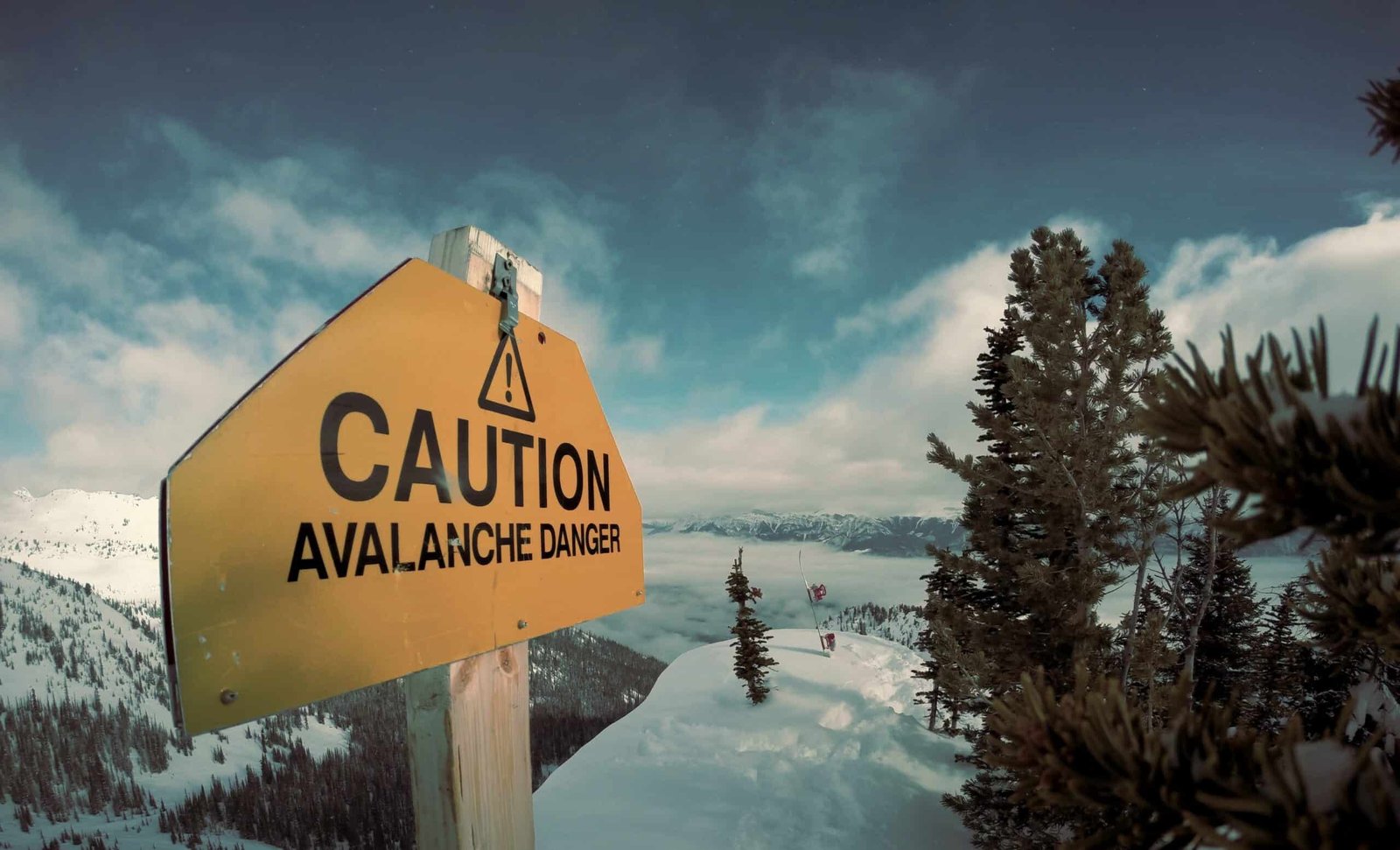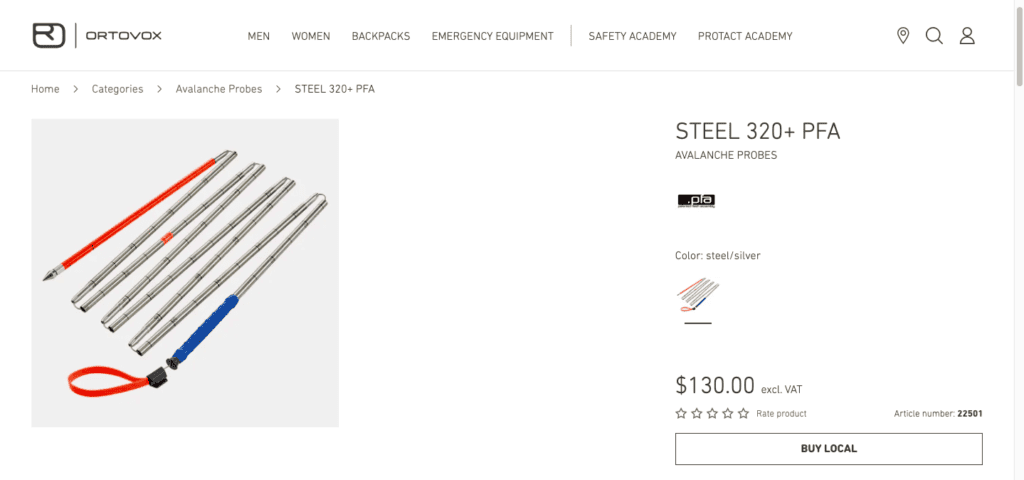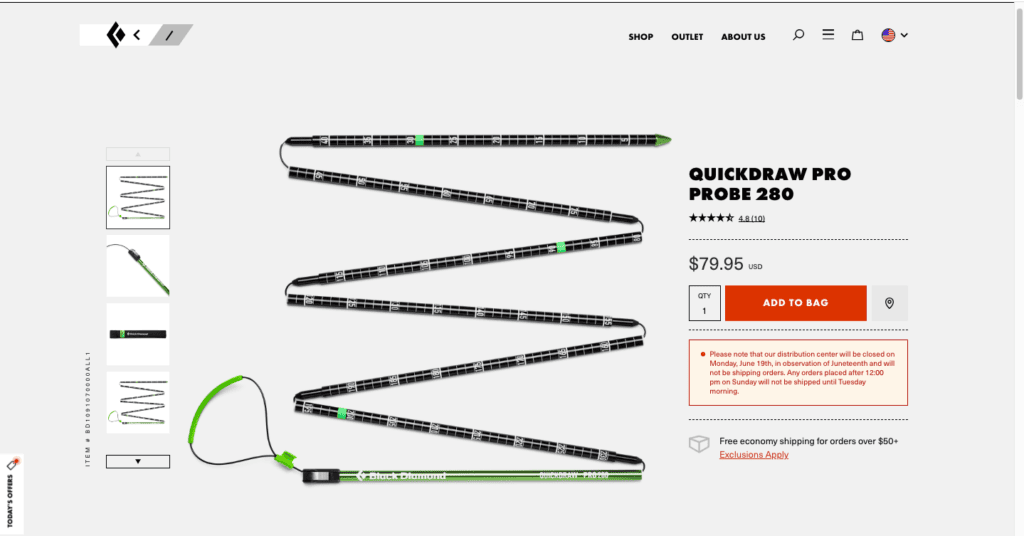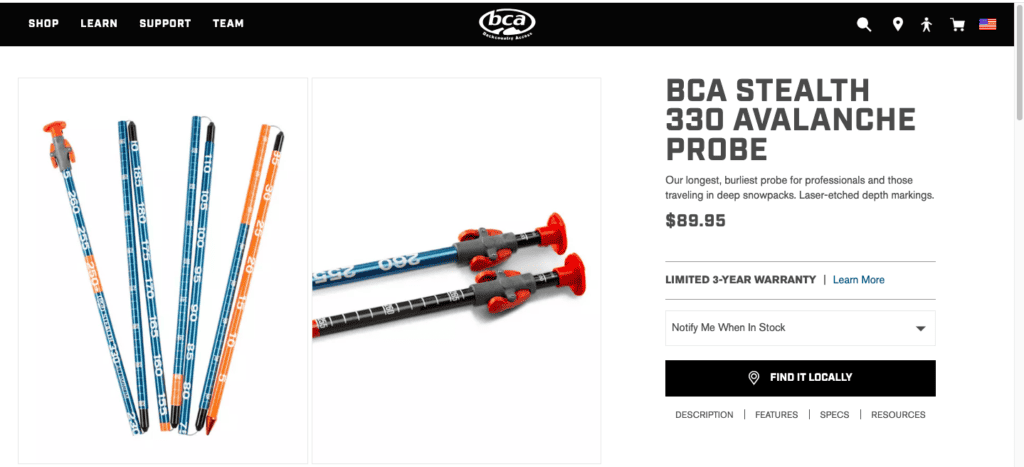Best Avalanche Probes for an Unforgettable Adventure in 2023

When venturing into the backcountry for skiing or touring, it’s crucial to prioritize safety and be prepared for unforeseen situations. Among the essential avalanche protection equipment, the focus is on finding the best avalanche probes. These probes play a critical role in identifying victims buried in snow and assessing the snowpack’s depth.
To aid you in making an informed choice, we have compiled a list of the 5 best avalanche probes available. In urgent scenarios, a quick and efficient response is vital, which is why these probes are designed for easy operation and swift deployment. With their well-constructed design and compact packaging, these probes ensure you have the necessary tools to tackle avalanche situations effectively.
Best Avalanche Probes in 2023
Discover the top-rated avalanche probes for efficient snowpack assessment and rescue. Stay prepared and safe in the backcountry with our curated selection of the best avalanche probes available. Whether you are a beginner skier or an experienced one, having the right gear is essential to staying safe and having fun.
Ortovox Steel 320+ PFA

The Ortovox Steel 320+ PFA is a professional-grade avalanche probe designed for rescue organizations and backcountry travelers. It features strong steel construction with robust steel cable combining eight sections, as well as a PFA deployment system that allows for quick assembly. The probe also has depth markers, a quick-release cover, and an extendible design that reaches up to 320cm in length.
The Steel 320+ PFA is incredibly durable and reliable, making it perfect for any situation where you need to search for someone buried under the snow. The rubberized grip makes it comfortable to use even in cold weather, while the easy-to-read depth markers help you accurately measure the depth of the snowpack.
Mammut Carbon Probe Light 240

The Mammut Carbon Probe Light 240 is an essential tool for any backcountry enthusiast. It is designed to be lightweight and durable, making it perfect for long days of touring and frequent pit work. The 280 cm length is ideal for probing deep snow or rocky terrain, and the integrated telescopic locking system ensures reliable tensioning. The probe segments are made from high-quality carbon, making them both stable and lightweight. Additionally, the drop-shaped probe tip allows for energy-saving probing without sacrificing accuracy.
In terms of design, it is a great choice for backcountry or powder adventurers. It is compact enough to fit in a backpack or avalanche pack without taking up too much space while also being light enough to race with. The precise probe scaling makes it easy to accurately detect buried objects, even in difficult terrain conditions.
When it comes to ease of use, the Light 240 is quite straightforward and simple to operate. The telescopic locking system allows you to quickly set up and deploy the probe when needed. Additionally, the probe can be used with gloves on if necessary, which makes it even more convenient in cold weather conditions.
The durability of the Light 240 is also impressive; it can withstand harsh conditions without breaking or bending easily. This makes it a great choice for those who want a reliable tool that will last them through multiple seasons of backcountry travel.
Black Diamond Quickdraw Pro 280

The Black Diamond Quickdraw Pro 280 is an essential piece of gear for any outdoor enthusiast. This probe is designed to provide fast deployment and maximum durability in the backcountry, making it a must-have for avalanche safety.
The Quickdraw Pro 280 features seven aluminum sections and a stainless steel cable, providing a balance between weight savings and durability. The dual quickdraw speed ferrules make deployment incredibly fast, while the rapid deployment stuff sack makes packing up quick and easy. The medium length of the probe is perfect for backcountry users who want to be prepared without carrying too much extra weight.
When it comes to performance, the Quickdraw Pro 280 does not disappoint. Its lightweight design makes it easy to carry around on long hikes, while its sturdy construction ensures that it can handle whatever terrain you encounter along the way. Additionally, its stainless steel cable adds extra durability, so you can trust that your probe will last through multiple seasons of use.
Backcountry Access Stealth 330

This probe is designed for backcountry skiers and snowboarders who need a reliable and durable tool to help locate and rescue avalanche victims.
One of the unique features of the Backcountry Access Stealth 330 is its quick-locking system. This allows the user to easily and quickly assemble and disassemble the probe, making it a great option for emergency situations. Additionally, the probe has depth markings on the shaft, providing accurate measurements during search and rescue operations.
The build quality of the Backcountry Access Stealth 330 is impressive, with a sturdy aluminum shaft that can withstand heavy use and abuse in harsh outdoor environments. The probe is also lightweight, weighing in at just 9 ounces, making it easy to carry in a pack or even a jacket pocket.
Safety features are another important aspect of this probe’s design. The tip of the probe is designed to be highly visible and reflective, making it easier to locate in low-light conditions. The probe also has a tapered tip, which can help prevent injury to the victim during a rescue operation.
G3 Speed Probe 240

The G3 Speed Probe 240 is a lightweight and dependable avalanche probe designed for recreational users and professionals. It is made from aluminum 7001-T6 tubing, making it strong and reliable while still being lightweight. The single-pull quick deployment is completely resistant to icing, and the probe has been 100% tested for quality assurance.
This avalanche probe is perfect for those who want to go light and fast but still have durability. It has a very good size of the segments that make it easy to assemble quickly in an emergency situation. In addition, the adjustable tension system makes it easier to adjust the length of the probe without having to worry about slipping or jamming.
The build quality of this avalanche probe is excellent, with its aluminum 7001-T6 tubing providing strength and reliability while still being lightweight. The design also incorporates safety features such as a locking mechanism that prevents accidental deployment in case of an emergency. Additionally, the probe has been tested for quality assurance, so you can be sure that it will perform when you need it most.
In terms of performance, this avalanche probe does not disappoint. It is easy to assemble quickly in an emergency situation due to its good size segments, and its adjustable tension system ensures that you can easily adjust the length of the probe without worrying about slipping or jamming. Furthermore, its lightweight design makes it easy to carry on long trips or hikes without feeling weighed down by your gear.
Aluminum vs Carbon vs Steel
When it comes to selecting an avalanche probe, the material is an important factor to consider. Here’s a breakdown of the differences between aluminum, carbon, and steel avalanche probes:
Aluminum Avalanche Probes:
Aluminum avalanche probes are the most commonly used type of probes on the market. They are lightweight, affordable, and are generally considered to be the most durable option. They can be bent and straightened without breaking, which is a useful feature for multiple uses. Aluminum probes are also resistant to corrosion and can withstand extreme temperatures.
Carbon Avalanche Probes:
Carbon fiber avalanche probes are the lightest and thinnest probes available. They are ideal for backcountry skiers and snowboarders who prioritize weight over durability. They are also popular among mountaineers and alpine climbers because they are easy to carry in a backpack. However, carbon fiber probes are more expensive compared to aluminum and steel, and they tend to be less durable in the long run.
Steel Avalanche Probes:
Steel avalanche probes are the most durable type of probe available. They are thicker and stronger than aluminum and carbon fiber probes, making them ideal for professionals who use them frequently. Steel probes are also more affordable compared to carbon fiber probes. However, they are heavier and bulkier, which makes them less convenient to carry around.
Ultimately, the decision between aluminum, carbon, or steel avalanche probes depends on the user’s specific needs. For most recreational users, an aluminum probe is sufficient. For professionals or those prioritizing weight, carbon fiber may be the best option. For those who want durability above all else, steel is the way to go.
Avalanche Probe Length- 240 cm, 280 cm, 320 cm?
Avalanche probes come in a variety of lengths, with the most common being 240 cm, 280 cm, and 320 cm. The length of the probe you choose will depend on your needs and preferences. For example, if you are looking for a probe that is lightweight and easy to pack, then a shorter length may be best. On the other hand, if you need more reach or stability when probing deep snowpack layers, then a longer probe would be recommended.
No matter which size you choose, it’s important to ensure that it is made from durable materials that can withstand extreme temperatures and harsh conditions. Additionally, look for probes with depth markings that are easily read in all light conditions.
When shopping for an avalanche probe, it’s also important to consider the features offered by different brands. Some probes come with quick-connect systems that allow for fast assembly and disassembly, while others feature adjustable handles for improved comfort during use. It’s also worth noting that some probes are designed specifically for backcountry skiing or snowboarding, while others are suitable for general rescue applications.
Features to Consider When Choosing an Avalanche Probe
When heading into avalanche terrain, safety should always be a top priority. Along with other essential avalanche safety gear, an avalanche probe is a crucial tool that can make all the difference in a rescue operation. However, not all probes are created equal. Choosing the right one is an important decision for any backcountry traveler. When selecting a probe, there are several features to consider.
First, the length of the probe should be taken into account. Generally speaking, probes should be at least 2 meters long to ensure that you can easily find a victim in the event of an avalanche. Shorter probes may be lighter and more portable, but longer probes will provide greater reach and accuracy when searching for a buried person.
Second, consider the material of your probe. Carbon probes are typically lighter than aluminum probes, but aluminum is more durable and suitable for everyday use.
Third, think about how easy it is to assemble your probe. Look for a simple assembly system with few parts that can quickly be put together in an emergency situation.
Finally, take into account the depth of snow in your area when selecting a probe length. In shallower snow packs or during early or late season conditions, shorter and mid-length probes (240cm and 280cm) may be sufficient; however, longer probes (320cm) may be necessary in deeper snow packs or during peak winter conditions.
How to Use an Avalanche Probe Effectively
When venturing into the backcountry, safety is crucial, and knowing how to use your avalanche probe properly can make all the difference. The first step is to ensure you have the right equipment and have familiarized yourself with its features. Once you’ve assembled your gear, practice deploying your probe correctly, as time is of the essence in an avalanche rescue.
Remember that successful probing relies heavily on effective communication between your teammates, so ensure you are familiar with the probing techniques and signals agreed upon beforehand. Of course, the most important tip for using an avalanche probe effectively is to stay calm and focused under pressure. With these strategies in mind, you can confidently navigate the backcountry and approach avalanche rescue situations with confidence.
Safety Tips for Operating and Using an Avalanche Probe
When planning a backcountry excursion, the last thing on our minds is usually the possibility of an avalanche. But unfortunately, it’s a real risk that we need to be prepared for. If you’re planning on going off-piste, make sure you have a reliable avalanche probe and know how to use it.
Firstly, make sure you’re using a probe that is long enough for the snowpack in the area you’re skiing or snowboarding. Additionally, it’s important to hold the probe in a consistent position and move it deliberately to ensure you cover all the ground in your search.
Be sure to practice using your probe in a safe, non-emergency environment to ensure you are comfortable with it when it really counts. Remember, being prepared and educated is the best step in ensuring your safety while out on the slopes.
With all of the options and features out there, it can be difficult to choose the best avalanche probe for you. Thankfully, this guide has provided some valuable information that should help make your decision easier.
The most important thing to consider is your own safety in an avalanche situation – no matter what kind of probe you use, always ensure that you follow proper safety precautions. Additionally, remember to practice using your probe before heading out on an adventure by recreating a simulated avalanche experience.
If traditional probing isn’t feasible for you, then other alternatives, such as airbags and snowmobiles, are definitely worth looking into. In the end, choosing a quality probe with user-friendly features will guarantee the effective use of a tool made specifically for locating and measuring snowpack thicknesses quickly and accurately.
FAQs
What does a probe do in an avalanche?
In case of any avalanche accident, it is used to analyze avalanche debris. It helps identify where the dead person is and measures the deepening of the body. This allows the use of avalanche investigation devices for rapid action as well as the prevention of avalanches.
What is the probe line technique?
Professional rescuers usually initiate the Probe line. In avalanche investigation lines, rescuers insert probes into the snow and then advance in a line. This is an effective albeit slow way to search an area, as each person in the line takes turns probing the snow. The spacing between each person should be fingertip-to-fingertip, and the probes should be inserted perpendicular to the slope and at least as deep as the distance reading indicates.
You will be asked to choose the appropriate probe length according to the depth and intended usage. In deeper Colorado snow, Stealth 240 could suffice. If we have a deep snowpack or travel through deep snow, we need longer tests.
Is an avalanche probe necessary?
It is an essential piece of safety equipment for anyone who plans to travel in avalanche terrain. It is used to pinpoint the exact location and burial depth of a victim in the event of an avalanche. Avalanche probes are lightweight, compact, and easy to use, making them a necessary addition to any backcountry skiing or snowboarding kit.
Conclusion:
Whether you are just getting started in the winter backcountry or an experienced snow enthusiast, having the right avalanche safety gear is essential. An avalanche probe is a key piece of equipment for anyone traveling in areas with potential avalanches.
The right length and type of probe will depend on your needs and conditions, so make sure to do your research before setting out into the winter backcountry. With a good avalanche probe, you can be sure that if an unfortunate situation does arise, you will have the tools necessary to quickly and accurately locate any buried victims.






